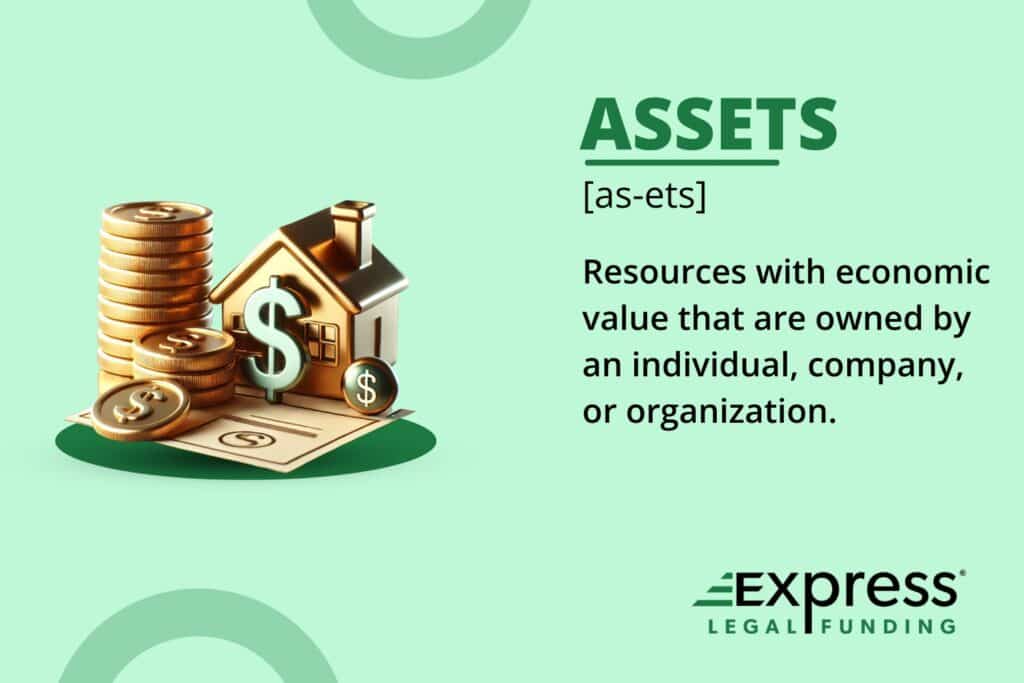What Are Assets?
In both legal and financial contexts, assets are anything of value that an individual, business, or entity owns.
Assets can include cash, real estate, investments, and personal property. Understanding assets is crucial when dealing with lawsuits, settlements, and legal funding, as they often impact financial decisions, eligibility for funding, and valuations.
What Is an Asset in Legal Terms?
In legal terms, an asset is any item, resource, or property owned by a person, a group of individuals, an organization, or an entity holding a particular economic value, including real estate property, vehicles, and cash.
Individuals and organizations use assets to engage in financial transactions and ownership transfers: Buying/selling and inheriting and can be used as collateral to obtain a loan or mortgage. Some common examples of assets include:
- Cash
- Real estate properties
- Investments
- Patents and Copyrights
- PPE (Property, Plant, and Equipment)
- Inventory
- Intellectual property such as trademarks, copyrights, and patents are also assets.

What Are the Different Types of Assets?
For legal and accounting purposes, legal assets are categorized into various types based on their nature and value.
Types of Assets
Some common asset types include:
- Tangible Assets
- Intangible Assets
- Financial Assets
- Current Assets
- Fixed Assets
Tangible Assets
Tangible assets have a physical form and can be touched or quantified by some means. Examples of tangible assets include properties, vehicles, jewelry of precious stones, machinery, and more.
Intangible Assets
Intangible assets cannot be easily quantified and usually lack physical existence. Nonetheless, they hold value to the owner and can be used for their financial gain. Examples of intangible assets include patents, trademarks, intellectual property, and more.
Financial Assets
Financial assets are usually prominent in transactions, are quantifiable, and can be invested to generate income or capital appreciation. Examples include cash, stocks, bonds, mutual funds, etc.
Current Assets
Current assets can be converted to cash in the immediate future and are usually short-term investments. Examples include inventory, prepaid expenses, and accounts receivables, all of which are expected to be turned into cash by the company.
Fixed Assets
Fixed assets, also known as capital goods, include property, plant, and equipment (PP&E); fixed assets are long-term investments that cannot be easily converted to cash. These include land, buildings, and machinery.
What Is an Example of a Depreciating Asset?
A depreciating asset is any asset that loses value over time due to factors like wear and tear, obsolescence, or market conditions.
Examples include:
- Vehicles (e.g., cars, trucks): Lose value as they age and accumulate mileage.
- Electronics (e.g., computers, smartphones): Become outdated as newer models are released.
- Machinery & Equipment: Deteriorate with use and technological advancements.
- Furniture & Fixtures: Experience wear and tear over time.
Depreciation is commonly accounted for in financial statements to reflect the declining value of these assets.

What Asset Cannot be Depreciated?
While most assets lose value over time, others do not depreciate as they maintain value. In fact, the property will typically appreciate and increase the owner’s net worth. Some types of assets that do not depreciate include the following list:
- Land: Land, as an asset, is considered to never diminish in value over time. On the other hand, any enhancements made to it, such as buildings, may depreciate with time.
- Intellectual Property[IP]: Certain IPs, such as copyright or patents, may be amortized with time depending on their utility & value; Intellectual Property, as such, is considered a non-depreciating asset.
- Investments and Financial Securities: Although stocks and bonds can lose value by being subject to the economy and the stock market, they are usually not perceived as depreciating assets. Still, that does not mean their value may fluctuate over time based on many factors.
- Collectibles: Any rare collectibles, such as artwork, antiques, and rare coins, are considered non-depreciating assets. However, their value can fluctuate from time to time due to the level of demand by collectors.
What Is the Difference Between Assets and Liabilities?
Assets are economic and financial resources owned by an individual, business, or organization. They can be tangible (e.g., cash, real estate, equipment) or intangible (e.g., patents, trademarks, goodwill) and typically provide financial value or income over time.
Liabilities, on the other hand, represent financial obligations owed to another party. These obligations arise from past transactions, contractual agreements, or debts that require repayment. Common liabilities include loans, mortgages, accounts payable, and credit card debt.
The key difference is that assets contribute to financial growth, while liabilities reduce financial resources. Together, they impact an entity’s net worth:
- Positive net worth occurs when total assets exceed total liabilities.
- Negative net worth occurs when liabilities outweigh assets, indicating financial instability.
Effectively managing the balance between assets and liabilities is crucial for maintaining financial health.
How Are Assets & Liabilities Connected to Net Worth?
Net worth, also known as total equity, is the calculated value of the financial resources of an individual or entity. Net worth is calculated using assets and liabilities.
A positive net worth implies that the owner has more assets than outstanding liabilities, which means they own more assets than they owe and are not upside-down with debt (total negative equity).
How to Calculate Total Assets?
The total assets represent the cumulation of all assets owned by an individual, group, or entity. To calculate the total assets, the following steps may come in handy:
- Prepare a list of all the owner assets, including cash, bank accounts, property, etc. Note all liabilities, if any exist, that the owner must fulfill.
- Segment the asset into various categories. Some assets can be capitalized as long-term investments. Categorizing the assets can help better understand a company’s net worth and value.
- Research and assign value to the assets. An assigned fair market evaluation of an asset will often reflect current market trends and the economic climate. Certain assets, such as property, can be assigned values based on their future appreciation. An accountant can help you ascertain these values accurately.
- Add together all the calculated values of the assets to arrive at the final amount.
- If there are any liabilities, depending on the type, they will typically affect the total estimated equity amount by reducing it.
How to Protect Assets from Lawsuits?
Asset protection measures become crucial to avoid leaving your assets vulnerable to creditors or lawsuits. This becomes even more pertinent if you are in a profession with a higher risk of getting sued and lawsuits. In a lawsuit, very few assets are shielded from claims.
For instance, cash, bank accounts, real estate properties, expensive collectibles, jewelry made of precious stones, and the like are subject to a claim in a lawsuit. A general exception to this would be 401(k), employer-sponsored IRA, or retirement account.
There are many routes you can take to protect your assets. We recommend you seek legal advice from an attorney to evaluate if you have any potential liabilities and learn about your options. Some ways people and companies use to protect their assets from lawsuits include.
- Insurance: Purchasing liability insurance is a great start to protect your assets in case of a lawsuit. For instance, doctors can get insurance against medical malpractice or real estate agents for errors and omissions coverage. These are just a couple of examples we have cited. Many more types of insurance coverage can be an option, such as commercial liability insurance, Worker’s Compensation insurance, auto insurance, or umbrella coverage.
- Separate Personal & Business Assets: Establishing a separate legal entity, such as a limited liability company (LLC), and maintaining a formal operating agreement is essential. This separation helps protect your personal assets if your business faces a lawsuit.
- Retirement Accounts: Consistent contributions to retirement plans, such as 401(k)s, will help to safeguard your assets from lawsuit claims. IRA offers only limited protection in lawsuits and is open to claims after reaching a specific dollar amount.
- Transferring Assets: Creditors cannot claim assets that the debtor does not own. Transferring assets to trusted persons via Irrevocable/Unbreakable trusts can help in asset protection. However, this could be fraud, depending on state laws and the exact circumstances.
- Homestead Exemptions: This protects homeowners from losing their property in lawsuit claims. Although this varies from one state to another, some states are at the forefront for having the broadest terms and unlimited dollar amounts for homestead exemptions, including Florida, Iowa, Kansas, and Texas.
- Setting up DAPT: DAPT, or domestic asset protection trust, shields assets from lawsuits. This trust offers varied levels of protection based on the state.
What Does it Mean to Liquidate Assets?
Liquidating assets means converting assets to cash or cash equivalent forms. When an owner needs cash immediately, they often liquidate an asset to have more liquidity for upcoming expenses or investment opportunities. In addition to raising funds, people may liquidate assets to clear liabilities or close a business entity.
Selling assets directly in the open market is the most common way of liquidating assets. This is particularly true for real estate, bonds, mutual funds, etc.
In cases where more than one party/individual has a claim on the asset, the proceeds after liquidation will be divided among them based on their ownership stake in the asset.
It is important to note that the laws governing asset liquidation may vary from jurisdiction to jurisdiction. It is advisable to consult an attorney to understand the various options for your assets.
What Does it Mean to Capitalize an Asset?
Capitalizing an asset is when a company classifies a particular expenditure as an asset instead of an expense. Doing so increases the owner’s net worth on a balance sheet. The asset may undergo depreciation or natural amortization over time.
Some commonly capitalized assets include Property, Plant, and Equipment (PPE) and intangible assets such as intellectual property, patents, and copyrights.
How to Calculate Return on Assets?
ROA, or Return on Assets, is a type of Return on Investments (ROI) metric used to evaluate how efficiently a company’s asset utilization generates revenue and, subsequently, profits. In order to calculate the Return on Assets profitability ratio for a company, the following math formula is used.
The formula for ROA: ROA = Net Income / Average Total Assets
ROA indicates the percentage of profit generated for each dollar of assets currently owned. The higher a company’s ROA amount, the better, with some industries expected to have higher amounts than others.
What Assets Are Subject to PA Inheritance Tax?
The state of Pennsylvania (PA) imposes a tax on the inheritance of certain assets. When the owner passes, the assets transferred to the beneficiary are liable to pay an inheritance tax, and the rates vary depending on their relationship.
Different Pennsylvania Inheritance Tax Rates:
- 4.5% for descendants
- 12.5% for siblings
- 15% of the assets being transferred to other heirs, except for charitable organizations and other entities already exempt from paying tax
The assets that fall under this bracket in Pennsylvania include the following:
- Tangible Personal Property: Real estate located in Pennsylvania, cash, vehicle, furniture, and more (Out-of-state real estate is not taxed).
- Intangible Personal Property: Bank accounts, mutual funds, stocks, and more
Jointly-Owned Property: The decedent’s fractional interest in a property is subject to inheritance tax.
